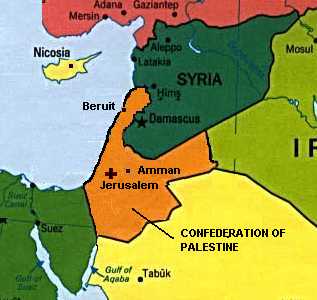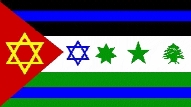

The Intelligence Services Section (ISS) of Foxx Industries has amassed the following information on this country.


Perhaps the best example of peaceful coexistence of different cultures is demonstrated in 24th century Palestine. After over a century of periodic wars in the 1900s, the nations of Israel, Jordan, and Lebanon joined together with the new nation of Palestine, vowing to coexist peacefully, each ruling its own citizenry, but all occupying the same territory. The people of Palestine itself are slightly more numerous than the people of the confederation's other nations, and through their wisdom in settling conflicts, their example of tolerance for the cultures with which they share the land, and their absolute refusal to put up with fighting in the confederation, they have been the glue that holds all together.
Population: 20 million (79% urban, 21% rural), Unemployment Rate: 12.03%, Literacy: 85%, College Educated: 56%, Average Life Expectancy: 81.3 years (male), 84.6 years (female) Largest Cities: Amman 3.0 million, Beruit 2.8 million, Jerusalem 1.6 million, Major Languages:Arabic, Hebrew, French
Jerusalem is the capital of both the Confederation and the nation of Palestine. Amman is the capital of Jordan and is the largest city in the Confederation. Beruit is the capital of Lebanon and is also the Confederation's largest port on the Mediterranean Sea. Tel Aviv is the capital of the Israeli nation. Arabic is the primary language in Jordan and Palestine. Hebrew is spoken in Israel, and Arabic and French are spoken in Lebanon.
Labor Force: 9.7 million (Agricultural: 2.10 %, Skilled: 28.16 %, Service: 48.44 %, Unskilled: 21.30 %), Industrial Capacity: 4.8 Rudell Units, Contribution to World Industry: 0.2 %, Agricultural Output: 98 % (net importer of grain, net exporter of citrus and truck produce), Mineral Output: 45 % (net importer of metals), Power Production: 100 %, Gross Domestic Product (GDP): 60.6 BLv, GDP per capita: Lv 3,009, GDP World Ranking: 64, Exchange rate: (Confederation Kravat to French Livre): 2.39 : 1 Trading Partners: Arabia, UAR, France
The Confederation is both an importer and exporter of agricultural goods; citrus crops and garden produce are exported and grains are imported. Mineral production is limited, and is comprised primarily of potash and limestone. The Confederation is self-sufficient in terms of power production although it is not uniform. Power transmission grids from the desert areas send power to the coastal areas, especially Lebanon.
Each country of the Confederation produces its own currency: the Israeli Shekel, the Lebanese Pound, the Palestinian and Jordanian Dinar. Over the last century, the Confederation Kravat has become more common and is the only currency accepted outside of the Confederation. The local exchanges rates vary, but are typically close to unity with the Kravat as any large fluctuations would cause economic instability.
Arabia and the UAR are among the principal trading partners of the Confederation as they have common borders with the Federation. France is also a trading partner with favored status; a remnant of the period of French Peace in the Middle East.
Government Type: Confederation, Prime Minister: Chaim Weizman (Israel), Minister of Defense: Tahal Faisal (Jordan), Minister of Economics: Gilead Moawad (Lebanon), Minister of Foreign Affairs: Rafiq Aoun (Palestine), National Budget: 9.2 BLv
The government structure of the Confederation is, to say the least, complex. Each of the constituent nations maintains their own government and also participates in the Confederation government. Israel, Palestine and Lebanon are parlimentary democracies and Jordan is a constitutional monarchy.
Israel is divided into three administrative districts: Southern, Central, and Northern. Parliament consists of only one chamber, known as the Knesset, which consists of 120 members who are elected by the people to four year terms. The party or coalition of parties having a majority in the Knesset forms the cabinet which holds executive powers and is lead by the Prime Minister. Israel does not have a written constitution and is instead governed by a number of basic laws which together serve as the fundamental law.
Palestine is a parlimentary democracy which consists of two chambers. The common chamber consists of 200 members who are elected by the people every five years. The upper chamber is made up of members who are appointed by the parties of the common chamber to a variable length term. Membership in the upper chamber is strictly controlled and eligibility is defined by the constitution. Any party having seats in the common chamber may nominate a person to the upper chamber whenever a vacancy occurs. Once all nominations have been made, the common house votes, and the nominee with the majority of votes assumes the position in the upper house. In a unique twist, and to act as a check on what could become an elitist chamber, once the winner is known, the chamber must then vote on the length of term. Terms can range from one to ten years. Each member of the lower chamber casts a vote for X years and the term is determined by a simple arithmetic mean. The members of the upper chamber elect the Prime Minister and cabinet from within their ranks.
Lebanon's government consists of an elected president and his cabinet of twelve ministers. Each term lasts ten years and election occurs through a series of run-off elections for the each of the ministerial positions and that of the president.
Jordan is governed by a constitutional monarchy in which the Prime Minister is appointed by the King and a cabinet is named by the Prime Minister. The King also selects 30 persons to the Senate for eight year terms. The House of Representatives is elected by the population to four year terms. The King has the power to dissolve the lower house and has done so in times of crisis.
The government of the Confederation is made up of two houses. The Upper House consists of eleven members of each of the constituent countries who are appointed by their home governments. The Prime Minister is voted on by the Upper House from its membership and serves for a 5 year term. The nationality of the Prime Minister rotates each term so that each of the constituent countries is represented every fourth term. The other government departments are headed by ministers who are elected from the Upper House by the members of the Lower House. The membership of the Lower House is based on demographic representation with one member per 100,000 persons within each country.
Percentage of National Budget: 9.4 %, Breakdown of Military Budget: 84.9 % Ground Forces, 7.7 % Aerospace Forces, 7.4 % Wet Navy Forces, 0 % Space Navy Forces, Standing Military Personnel: Ground Forces: 39,000
Each nation raises and maintains their own military forces. The Confederation Department of Defense coordinates the national militaries to form a single armed forces for the Confederation. Units from the nations are purposely intermixed to prevent factions from forming. The majority of the military budget is consumed by the Army, with Aerospace and Wet Navy branches using the rest. The Confederation does not have any Space Naval forces. The Wet Navy is based in Haifa and Beruit on the Mediterranean Sea.
Location: Asian continent, Earth (Sol/Core), Neighboring countries: Syria, Iraq, Arabia, Area: 127,300 km2, Lowest Elevation: Dead Sea, 396 m below Sea Level
The Confederation of Palestine comprises all of the land of the four countries that comprise it except that there is no longer access to the Gulf of Aqaba on the Red Sea as that territory now belongs to Arabia. The southern half of Israel is comprised of the Negev desert with a mountainous area to the north. The Plain of Zebulun north of Haifa is fertile and under irrigation. Ninety percent of Jordan is desert with only a small area around the Jordan River under cultivation. Lebanon is mountainous with the coastal plain being fertile and heavily cultivated.